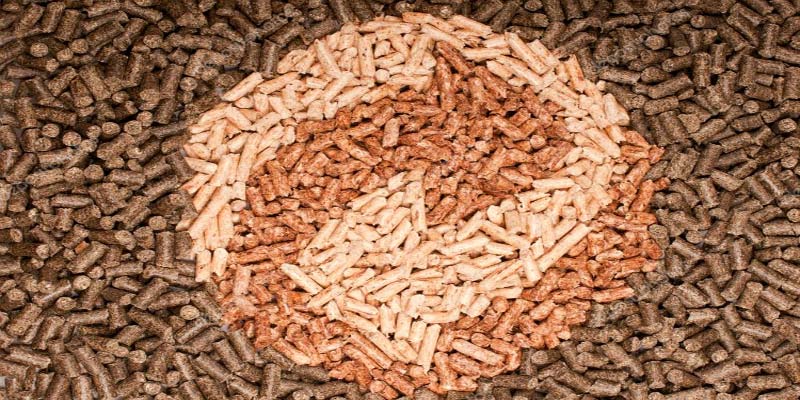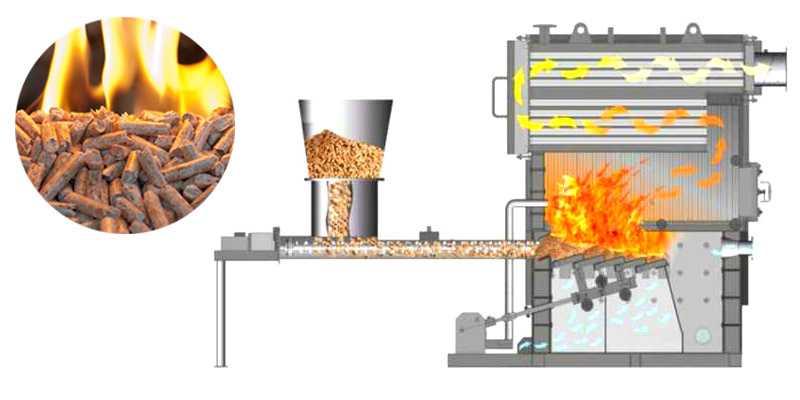With the advent of cold weather and before the start of the heating season, owners of pellet boilers are faced with a choice - which pellets to purchase. Since several tons are bought at one time, it is important to determine which product is being offered to you.
Manufacturers, as a rule, offer to get a trial batch and melt the boiler. But it is not always possible to test. In this article, we tried to systematize all the information about this type of fuel, so that customers have the opportunity to determine the quality of pellets without burning.

Production
Raw materials for wood pellets are sawdust, wood chips, shavings of various types of wood, illiquid wooden products, etc. On the wood pellet press, multiple grinding and drying of the raw material takes place. This device using a shaft and rollers squeezes the feedstock through the cells of the mould at a temperature about 250-300 C. Under these conditions, wood releases lignin, which is a natural substance, promoting the natural bonding of the pellets and maintains its integrity after cooling.
For this reason, wood pellets with high quality surface - smooth and shiny, it should not be with a lot of chips and cracks. This condition is ensured by compliance with the technology, the quality of the feedstock, and in particular compliance with the temperature regime.

Qualitative characteristics of pellets
The size
The size of wood pellets is standard 6, 8, 10 mm in diameter and 1 to 5 cm in length. Usually large manufacturers have several matrices of different diameters. ROTEXMASTER wood pellet machine can produce wood pellets with a diameter of 6,8,10mm in diameter.
First of all, it is necessary to get rid of the myth that 6 mm is a quality standard.
When choosing a size, you should be guided solely by the recommendations for your pellet boiler, since it is precisely for this size that its automation is designed. If you use pellets larger than indicated in the instructions, the pellet boiler mechanisms will experience increased load and will become unusable faster.
Consistency
It is worth paying attention to the hardness of wood pellets, for this you should divide it into two parts. See whether if it easily breaks, whether the fault site crumbles. High hardness will ensure the safety of the total mass in the big bag . This is important, because pellets are often poured and overloaded. It will be a shame if you bring products where a third of the volume is crushed into dust and a third is broken? To avoid this, you should find out the degree of abrasiveness of pellets.
In international certificates this parameter abrasiveness is designated as DU (mechanical strength). Press the fuel pellets weighing up to 100 kg for 1 min, and then blow them to sift the resulting wood pellets. If the products are of high quality, the volume of crumbled fine fraction should not exceed 1%.
It is worth noting that pellets are better preserved in bags and big bags than when shipped in bulk.
Smell
The smell of pellets may indicate the method of storage. When stored in humid rooms, the pellets give off with mustiness and dampness. Under normal conditions of storage and production, there is no odor or woody materials and does not consist of glue and chemistry.
Is light pellet good?
Today, the majority of buyers are looking for light pellets for purchase, believing that they will receive the highest quality product. In fact, light color is characteristic of hardwood raw materials, which are characterized by high heat transfer and hold their shape well. But, compliance with production technology is much more important, and color will tell about it a little. If the hardwoods are granulated at insufficient pressure and temperature, their color will remain the same light, and the granules will be soft and will crumble.
Or vice versa, at extremely high temperatures, they can burn and become darker, but retain high quality characteristics.
Often used species for the production of fuel pellets are coniferous wood: industrial wood, logging waste, pine bark, sawdust and wood chips, old wooden structures. Their color is darker, there are interspersed bark. But the dark color does not affect the quality: according to the ash content and other inspection points, they can meet strict European standards. It is ash content, the percentage of impurities - one of the key parameters of pellet quality.
Ash Pellet
This indicator characterizes the amount of ash that remains after burning pellets in boilers.
Ash content shows the ratio of the mass of ash to the mass of the burned fuel material. In this regard, fuel pellets are leaders among other types of alternative fuels. The ash content of the highest quality pellets can be less than 0.5%. An increase in the parameter of ash content of fuel pellets indicate poor-quality raw materials, which were used for the production of pellets or outdoor technology. Therefore, the higher quality raw materials you use, the lower the percentage of ash content of the finished product.
Low-quality pellets
It is known that consumers of products always want to save. Therefore, from several trading offers tend to choose the most inexpensive option. “Dear pellets are cheap, they will burn anyway,” as a rule, as a consumer thinks, who wants to save on fuel. However, the use of low-quality pellets has tangible consequences.
◆ Firstly, the consumption of such fuel is much higher, due to low heat transfer and abundant crumbling of pellets.
◆ Secondly, wood pellets with high ash content form slag cakes in the firebox - layers of sintered earth, sand and other inclusions. They interfere with the burning of wood and, as they grow, can lead to an emergency stop of the equipment. The boiler will have to be cleaned at times more often.
◆ Thirdly, low-quality fuel, as a result, leads to breakdown of the boiler. Ash clogs the combustion chamber, disables mechanisms. Thus, inexpensive fuel breaks down expensive equipment, and people who carried out expensive repairs due to the use of low quality pellets will never resort to such savings.

European pellet standards
A single European standard for pellets did not exist for a very long time. An example of this is previously the most common quality standards, such as: “Din” / “Din Plus” in Germany, the Austrian “O-Norm”, “SS” in Sweden. The Swiss “SN” and the British “process biofuel code” were less well known. In international trade in biofuels, especially in Europe, the German “Din” / “Din Plus” was most often quoted. Until now, even if the manufacturer does not have such an official certificate, but regularly orders research of its products in independent laboratories (preferably of European renown), the manufacturer indicates that its products meet the characteristics of the “Din” / “Din Plus” standard, which has its weighty word in Europe.
Please note that only since March 2010, a unified certification system for Europe is certification according to "EN 14961-2":
◆ EN Plus-A1 (premium pellets for domestic heating boilers)
◆ "EN Plus-A2" (pellets of standard quality for domestic heating boilers)
◆ "EN-B" (pellets for industrial use)
Which takes into account the quality standard:
◆ Diameter
◆ Length
◆ Bulk density
◆ Calorific value
◆ Water content
◆ Abrasion / dust volume
◆ Hardness
◆ Ash content
◆ Resin Melting Point
◆ Chemical elements
And also such parameters as: type and origin of raw materials, equipment used, features of the production process and method of shipment.
Former standards have lost their validity since the entry into force of the single European standard EN. Although many manufacturers / traders / buyers are still focused on Din, including those manufacturers whose production has previously been certified by Din Plus and their certificate is valid.
It is worth noting that these quality standards are not very different from each other. However, the main indicators considered are: diameter, length, bulk density (density), calorific value, humidity, ash content, sulfur and other solid particles, mechanical properties of pellets (percent abrasion and dust).
评论
发表评论